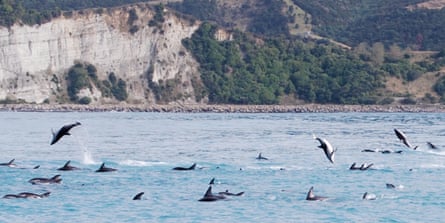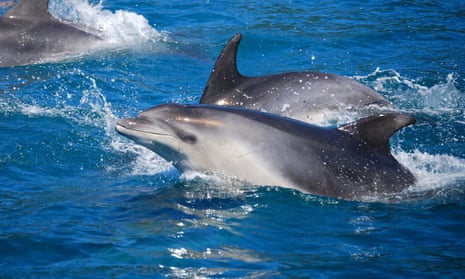This Thursday, 1 September, marks Japan Dolphins Day. Anyone following social media may well sigh. Isn’t there always a something-or-other day? Perhaps so, but with 100 demonstrations planned outside Japanese embassies and consulates worldwide, this event has a bitter and serious urgency: the soon-to-be continued slaughter of wild dolphins in the infamous inlet at Taiji, subject of Oscar-winning documentary The Cove.
Between September and April, up to 2,000 dolphins will be driven inland and killed for their meat. Cynically, those that look the prettiest and jump the highest to evade the butchers’ knives will be saved – to sell to oceanariums around the world. Those bloody waters, and the sight of sentient cetaceans leaping for their lives, should be enough to stir even the most cynical out of their complacency.
Earlier this year, the activist star of The Cove, Ric O’Barry, was detained by the Japanese authorities for two weeks. O’Barry was the original trainer for the Flipper TV series, capturing the five dolphins used for the show. But in 1970 he changed course and formed the Dolphin Project, fighting to free captive cetaceans and, in particular, to stop the Taiji cull.
“I’ve been operating out of guilt,” O’Barry tells me from his Miami home, as he prepares to leave for the London demonstration, “I helped create this industry.” Before 1959, when the Taiji cull began, there was no market for captive dolphins. Now oceanariums in China, Turkey, Russia, the Middle East and even the Caribbean will pay up to $150,000 per animal. Japan itself has 52 dolphinariums. O’Barry says that London is the key to changing the situation. “If we can get 10,000 people outside the Japanese embassy on Thursday, that will make the Japanese government take notice.” He notes that with the next Olympics to be held in Japan, the country will be keen to avoid adverse publicity. “If we can do that in London on 1 September, it will end this story once and for all.” Most especially, O’Barry is appealing to animal welfare organisations to pool resources and alert their members to attend.
The Taiji cull follows the resumption of the Faroe Islands’ annual hunting of pilot whales in July, known as the grind. This year, 200 whales were herded into the shallows and 120 were dispatched to be cut up by the islanders and eaten. Last Friday, a third grind saw another 40 whales rounded up and nine killed. This is despite warnings from the Faroe Islands government that, like the dolphins hunted in Japan, the high amounts of heavy metals in their meat can cause impacted immune systems, fertility problems, and premature dementia. A new film, made by Andrew Sutton in collaboration with David Attenborough, seeks to propose an alternative and more profitable venture for the islanders: whale-watching, rather than whale-killing.

Underlying all these issues, as pressing as they are, is a new and astonishing discovery. It comes in the shape of a scientific report released earlier this year which was shamefully under-reported. In it, the authors establish that for the first time it can be proved that the evolution of a species other than Homo sapiens has been affected by cultural change. This has been demonstrated in orca, or killer whales – the largest of the dolphin family, which are subject, like their cousins, to captive status in US, Europe, and Asia.
New Scientist magazine which, along with Nature, was one of the few publications to give the report prominence, explained that killer whale populations have different hunting strategies: “Some herd fish, while others pick on seals. Biologists consider this a form of culture. New research reveals these cultural groups are genetically distinct, meaning culture has shaped their evolution. It’s the first time this has been seen in other animals. Killer whales are intelligent, long-lived, and social like us. Culture is one more reason to set them free.”
What is remarkable about this statement is the unusual undertow of unscientific emotion it expresses. Scientists I have spoken to say this report is a defining one: that it has the power to change the way we see other species.
In his famous 1988 poem, Heathcote Williams celebrated a Whale Nation. Yet the fact that cetaceans recognise no national boundaries sits uneasily with the way their fates are dealt with over our borders – geographical and metaphysical. Ironically, as Franz de Waal notes in his new book, Are We Smart Enough to Know how Smart Animals Are?, it was a Japanese primatologist, Kinji Imanishi, who first proposed in 1952 “that we may justifiably speak of animal culture if individuals learn habits from one another resulting in behavioural diversity between groups”. Western scientists rejected Imanishi’s naming of individual animals as too anthropomorphic. Only later would it be acceptable to name dolphins, elephants or primates in order to better track their “social careers” over many generations.
If we accept that an animal other than us can be evolutionarily transformed by culture, how can we countenance the treatment of that animal as a captive? Who passed sentence on the dolphin or the orca, the primate or the elephant? It’s time we caught up with the Greek poet Oppian, who declared in the 2nd century that the hunting of dolphins was immoral.
O’Barry feels his own mortality creeping up on him: “At 77, I’m running out of time,” he says. It’s hard not to share his frustration. How many dead poets, how many dolphin days, how many scientific papers does it take to make us realise how close we are to these animals, and how outrageous our treatment of them is?

